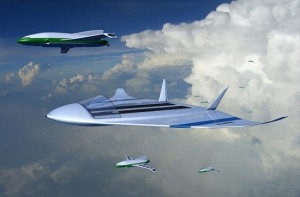
When it comes to aircraft, bigger is better. As size increases, so does efficiency, which is the thinking behind the monstrous Airbus A-380. But to be really efficient, you’d need to go bigger. Way bigger. We’re talking an aircraft so large that other aircraft could land on it, in-flight.
The “Airborne Metro” concept is just that: it’s like an express train in the sky. As part of a general metro or train system, though, you don’t get to take the express line directly from start to finish. Instead, you take a smaller bus or train to get to the express train, and then probably another smaller bus or train to get to your final destination once you get off the express. In the case of the Airborne Metro, you’d catch a regular aircraft at a regional airport, zip up to a giant flying airport, and then ride that for a couple thousand miles before taking another regular aircraft back down.

This giant flying airport would be able to carry some 3,000 passengers at once, and would either allow conventional aircraft to land directly on its back, or would employ some sort of docking procedure to transfer passengers on and off. Having one of these things take off and land all the time would be extremely inefficient; instead, a nuclear reactor of some kind would provide in-flight power.
The concept envisions fleets of these huge airplanes flying continuous circuits from LA to Chicago to New York to London, over Europe, and back again. To fly a long distance, you’d simply hop a ferry flight up to the next giant express plane, transfer, and then chill out until you got close to your destination. Then you’d grab another little commercial craft to wherever you’re going. This would be faster and more efficient for passengers, and would contribute to an overall fuel savings of 40% for a 600-mile trip, all the way up to 80% for a 6,000-mile trip.
We’re obviously still waaay behind the technology curve necessary to make this happen, but if we ever do manage it, it could revolutionize air travel as we know it.
Via: Dvice

 Follow
Follow